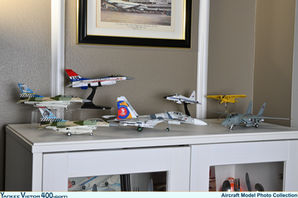DelPrado 1:400 Cubana IL-76 review and mould comparison
- Retrohangar Diecast

- Sep 9, 2024
- 7 min read
When you're looking for a 1:400 Ilyushin IL-76 on eBay, the ones made by Aeroclassics and Wittywings are often far above retailprice. This bothered me as this aircraft has been high on my wishlist for quite some time. Recently I found a cheaper alternative, which is this Cubana IL-76 by DelPrado, which you can find for less than €50 every now and then. Most of you probably never heard of this brand, let alone have one of their models in your collection, so what is this brand? Is the quality any good or is it better to save your money for an Aeroclassics / Wittywings release? Find out in this review! Please keep in mind that the Aeroclassics model will be called IL-76, even though it's meant to represent a Beriev A-50.

What brand made this model?
DelPrado is a brand that can be found on all kinds of scalemodels; aircraft, trains, cars, ships and hand-painted minifigures. This IL-76 comes in orange packaging, which includes the plastic blister with the model and a booklet about 100 years of aviation history. This particular model is nr. 15 of the "World Aircraft 100 Years Story" series. Unfortunately mine only had the plastic blister with the model. You can find this exact same model in black packaging by Model Power. I don't know what the relationship between these two brands is, but they definitely worked together. On the back of the Model Power box you can find all the models they produced for their "Airliner" collection, which includes a 1/250 TWA Boeing 307 Stratoliner. I have this model, but again in the DelPrado blister. It is rather strange to me how they have all these interesting moulds, but only used them once. Other aircraft in this collection are: L-1049 Super Constellation, DC-3, Dornier Do. X, L-1011 Tristar, Fokker 50, TU-144 and many more. The scales vary a lot and are sometimes a little weird; the Dornier Do. X is 1:375 for example.
Operational history of the aircraft
This IL-76 was delivered in 1984 to Cubana as CU-T1258 but was reregistred CU-C1258 in 1996 and then CU-C1419 in 2000. In 2001 it recieved an overhaul in Ukraine and operated for Aerocom between 2002 and 2005 as ER-IBE. It was then sold to the Angolan Air Force as D2-FCO, withdrawn from use in 2014 and scrapped at Luanda (Angola) in 2015.
Mould review
Normally I don't consider the mould in my reviews as it's already done by others like Yesterdays Airlines. For this model it's a little different, because at first it may seem similar to the Aeroclassics mould, but it's noticably different in almost every aspect. So let's compare them to see what the quality is like.
First the fuselage, specifically the cockpit area. Check these images as reference: Cubana and Aeroflot. Both are inaccurate; the DelPrado mould has the correct pointy nose, but the cockpit area is too flat and it has a large forehead. Aeroclassics' nose is too blunt and the forehead seems a little too large, but this because the cockpit windows are too small. The bulge for the navigator compartment seems fine on both, although just a little bit too small on the DelPrado.

The wingjoint design is different on these moulds and to be honest, I don't know which one I like more. Aeroclassics has the wings and wingbox as one big piece, meaning there is a noticable seam with the fuselage, while on the DelPrado model the wingbox is partly moulded with the fuselage, meaning there is a seam on top and below the wing. If you like taking pictures from a low angle, where the top seam is not visible, then DelPrado is a clear winner, but when displayed in a cabinet, Aeroclassics has my preference.
The gears are even more different than the wingjoint. The nosegear on the Cubana model should be more to the front but seems fine on the Aeroclassics model. The main landing gear of the Cubana is fixed in place by a screw, similar to the old Aeroclassics DC-9-10's. When removing this screw, you find another screw inside the fuselage which holds the wings. Quite fun to take it apart, but be careful to not rip off any paint. Aeroclassics' main landing gears are miles ahead. There is more detailling and they were very smart with the seam on the back, as it's positioned where the large rear doors of the IL-76 move up and down. This is not the case on the DelPrado model, where you can see the printed outlines going over the seam. One plus for DelPrado is having a standhole, which only fits their own stands. Aeroclassics has no standhole for their IL-76's.
Delprado Aeroclassics
The Aeroclassics Aeroflot IL-76 in these pictures is actually a Beriev A-50, which has a modified connection between tail and fuselage for a tail gun (and is not present on the Aeroclassics model), but for a regular IL-76 it's accurate and thus a fair comparison. Since the tail is a seperate piece, there is a seam, but barely noticable. Surprisingly, the DelPrado has its tail moulded together with the fuselage, how often do you see that in 1:400 scale? The DelPrado's horizontal stabilizers are plastic while being metal on the Aeroclassics mould. Both are pretty much identical in terms of shape and size, just a tiny height difference.

DelPrado left, Aeroclassics right
The wings have flaps and ailerons moulded in on both moulds, this is much better on the Aeroclassics mould. However, the inner flap extenders are missing, so there are six on each side instead of seven. DelPrado has seven extenders on each side, but the flap detailling is less accurate.

DelPrado left, Aeroclassics right
The engines are pretty much identical in terms of shape, but on the DelPrado mould the engine and pylons are one piece, while for Aeroclassics there is a seperate piece for the pylon, engine and exhaust. For both models the engines are too low, which you can see by comparing it to the height of the blue Aeroflot cheatline.
Mould conclusion
Both moulds have their differences and flaws. For me, the Aeroclassics mould is better overall; gears, cockpit, tail, flaps and ailerons are better and since my models are most often displayed in a cabinet, I prefer the wingbox aswell. The DelPrado IL-76 has a more accurate pointy nose and some may prefer the wingbox design. The only big issue for me is the cockpit shape. If you are a casual collector who does not look for the best possible accuracy, you will be fine with both, especially when taking the price difference into consideration.
Model review
Now we know the pros and cons of the mould, let's take a look at the artwork and QC using the same template as for my other model reviews.
There are 6 parts that will be given between 1 and 10 points, 1 being the lowest and 10 being perfect. In the end the average of these scores will be the final score.
Accuracy of colors

The Cubana IL-76 model has a red and blue livery with grey belly, wings, engines and horizontal stabilizers. The blue color should be a little darker, but everything else is good. The wheel rims should be green, but they didn't bother with it on the model.
Score: 8,5 / 10
Livery

The Cubana livery also has a thick and thin cheatline. At the front the black anti-glare panel goes too far down, which means the thick cheatline ends too early. At the rear the thick cheatline curves upwards too early, making it too wide at the bottom of the tail. This gives the blue parts a more square ratio instead of rectangular. It also has the orange wingtips and blue color on the engine pylons, but those blue parts are too small.
Score: 7.5 / 10
Logos, titles and stickers

While so far the model scores pretty good, from now on it will be less positive. Starting off with the Cubana titles; The font is good, but they are too small and should be more forward. The color should be dark blue, like on the tail, but are printed black on the model.
Score: 6 / 10
Other details
Here it's even more bad news. The registration is too small, printed black instead of blue and there should be more white space inbetween the letters and numbers. The registration is missing on the wings. The Cuban flag is printed quite well, but should be a little higher and closer to the cockpit windows. The front door is placed well relative to the nosegear, while it should be more forward together with the nosegear, I will not deduct points as I think it's better this way. The navigator windows all point upwards and don't connect so well with the grey nosecone, which itself is also not painted straight. A window underneath the wings is missing and the large rear doors don't go upwards too much, they should go into the thick cheatline as can be seen here. There is a little bit of detailling around the model which I appreciate, as otherwise it would look too much like a toy.
Score: 3,5 / 10
Paint and printing QC
It would not make sense to score the QC of paint and printing, as this model is 20 years old. One noteworthy issue is that they forgot to put silver paint on one of the engines.
Score: - / 10
Mould QC

The seams are tight and much better than some models we see released today. There is a mould seam visible on top, which they didn't sand properly. While some parts are not very accurate, the quality control is very nice and I don't see any other issues.
Score: 9 / 10
Conclusion
The total score is 34,5 / 5 = 6.9, which is a little higher than I expected. Just like with the mould, this model is totally fine for people who are happy to have an IL-76 for a lower price and look at models from a little distance. The mould is totally acceptable and for lots of people the printing is good enough. If you made it all the way to the end of this article and think "this quality is too low, but I still want an IL-76", then try your luck by posting on Facebook, the forums or visit an aviation fair.

- Mark
Retrohangardiecast on Instagram
Mark22 on MAF, 400SH, DAC and DIMA
Want to collaborate or let me review your product? Send me a message via the channels mentioned above!
All pictures are mine (unless stated otherwise) and may not be used without my permission!
































































Comments